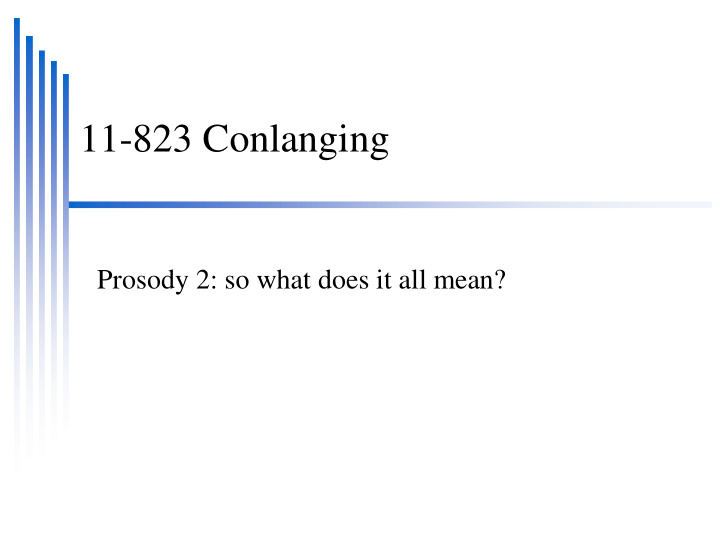



11-823 Conlanging Prosody 2: so what does it all mean?
Prosody Timing – Stress timed vs Syllable timed Accents/stress – Lexical/phonetic Emotion/style Semantics and intonation
Stress vs Syllable Timed Length of Syllables – equal(ish) or not – duh duh duh duh duh – duh duh DUH duh DUH duh DUH DUH Syllable timed languages – (Approximately) equal time for syllables – French, Japanese, Brazilian Stress timed languages – (sort of) equal time between stressed syllables – English, German, Portuguese
Other Timing Options For conlanging: Accent Groups/Intonational Phrases – equal(ish) timing – F0 range for stress – F0 range for sub-phrasing – Timing for sub-phrasing
Lexical/Phonetic Stress/Tone Change words with different prosody – project(n) vs project(v) – 橋 (hashi' bridge) vs 箸 (ha'shi chopsticks) 箸 – 媽 (mā mother) vs 馬 (mǎ horse) Wrong stress makes it hard to understand – Oregano, address – THE girl IN THE park with the teLEScope
What is emotional speech The standard 4 emotions Neutral, Happy, Sad and Angry But there are many more Cold-anger, dominant, passive, shame Confident, non-confident etc
English LDC Emotion (4 Emotions) Short, 1-2 second, wav files English speech – dates such as “ November 3 rd ” 4 fundamental, distinct emotions 74 unique workers and 169 total HITs completed Results Emotion % Correct Uni-directional Confusion Anger 69% Sadness 67% Neutral 66% Happiness 46% Total 60%
English LDC Emotion (15 Emotions) Same parameters as previous experiment. Including less well-defined emotions Pride, shame, etc. 68 unique workers and 218 total HITs completed Results Emotion % Correct Emotion % Correct Uni-directional Confusion Neutral 29% Happiness 9% Hot-Anger 26% Pride 9% Sadness 25% Despair 8% Boredom 17% Cold-Anger 7% Panic 14% Anxiety 5% Interest 12% Disgust 5% Shame 4% Elation 10% Total 12% Contempt 10%
German Berlin Emotion (7 Emotions) Short sentences with no emotional connotation “ The tablecloth is lying on the fridge. ” 37 unique workers and 245 total HITs completed Results Emotion % Correct Common Confusion Pair Neutral 68% 41.8% Anger 62% Sadness 53% Anxiety 45% Happiness 35% Boredom 27% Disgust 11% Total 41%
Conversational Prosody We change our intonation on context
Conversational Variation Base vs Conversational Recordings Base: “Okay” Conversational: “Okay” Variation over same prompt Different levels of apology etc
Context-dependent Recording Select 21 dialogs “Best” coverage of dialog acts Record 795 utterances Recording in a dialog “User” is just a synthesizer “User” is recorded actual user “User” is a human Dialog with human is more natural
3 speech databases General speech (ARCTIC prompts) 1128 utts, 51 mins, isolated utts from novels Let’s Go domain speech 2138 utts, 2hr16mins Isolated Let’s Go domain utts Let’s Go conversational 795 utts, 59mins Recorded in dialog with human “user”
Baseline model stats F0D MCD Arctic 12.685 5.685 LetsGo 9.088 4.952 LetsGoC 12.531 5.192
Conversational Responses • Answering “alright” in two different situation • Transcript • User: 5am • System: Leaving at 5am. Did I get that right? • User: Yes • System: Alright • Situation: Final state. After yes. • Tone: Terminating, delight
Conversational Responses • Answering “alright” in three different situation • Transcript • System: Okay. Penn Hills. Did I get that right? • User: No • System: Alright • Situation: After no. • Tone: Disappointment.
Conversational Responses Two occurrence of “Is this correct” Transcript System: What can I do for you? User: (silent noise). System: The 1C. Is this correct? User: (silent yes) System: The 1C. Is this correct? Situation: After no response. Repeated similar question. Tone: Delightful Demanding
Conversational Responses Two occurrence of “Did I get that right?” Transcript S: 61A leaving East Pittsburgh tonight? U: The 61A. Did I get that right? S: Going to Swissvale? U: The 61A. Did I get that right? Situation: After unrelated respond. Repeated similar question. Tone: Delightful Demanding
Style Styles: – Formal, informal – Performed, Conversational Genres – Didactic, Politics, Humor
Simple Intonation Use Contrast/Focus John saw Mark? BILL saw Mark Lists Strawberry, Apple, Banana. Strawberry, Apple, Banana, … Question/Declarative (ish) John saw Mary? John saw Mary. Confidence Traveling to downtown, when will you leave Traveling to downtown, when will you leave
More Complex Intonation Restrictive Relative clauses The Swiss who like chocolate Subset of all Swiss The Swiss, who like chocolate All Swiss (because they all like chocolate)
First/Second mention We intonationally reduce second mentions The man saw the boy in the park. The man gave him an ice cream
(non-)Verbal markers Fillers Uhm, em, eto, ano Well, so Hesitations, false starts Superfluous introductions … “like”, “you know” Cross lingual use
Prosody Phrasing, Intonation, Duration, Power Intonational Phonology Accent types F0 generate Lexical Intonation Tones, stress, lexical accent Combinations (Tone Sondhi, Fudge Rules) Pragmatics How people use intonational variants
Recommend
More recommend